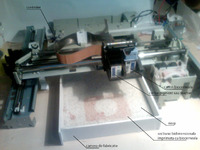 We are not making this up. It seems that there is always someone, somewhere trying to 3D print with practically any imaginable material. This time the mix is sand, pee (yes, human urine) and a certain type of bacteria. The premise is actually quite interesting: the bacteria (Sporosarcina Pasteuri) are capable of binding the sand’s silicon dioxide particles together by using a Urease Hydrolysis process. Basically, chemicals in the urine are used by the bacteria to fuse the sand together.
We are not making this up. It seems that there is always someone, somewhere trying to 3D print with practically any imaginable material. This time the mix is sand, pee (yes, human urine) and a certain type of bacteria. The premise is actually quite interesting: the bacteria (Sporosarcina Pasteuri) are capable of binding the sand’s silicon dioxide particles together by using a Urease Hydrolysis process. Basically, chemicals in the urine are used by the bacteria to fuse the sand together. Once this is understood, the rest is straightforward 3D printing engineering: sand is spread in a thin layer, bacteria are injected onto the sand layer in an appropriate pattern (likely with inkjet tech), and the bugs do their work. According to the paper:
The binding strength of the precipitated crystals is highly dependent on the rate of carbonate formation and under suitable conditions it is possible to control the reaction to generate hard binding calcite cement (or Biocement).
The resolution of this approach could be quite good, as it’s simply as fine as you can distribute the sand layer. In this case, they’ve managed to hit “100-500 micron layers”. Even better, this approach will not require any support material because lower layers of sand will support new layer builds. We’re wondering, however, about the length of time required for “curing”; how long does a bacteria take to do its job? How easy will it be to clean the object of loose sand particles? Can it be washed clean without compromising the structure?
Via Lights


@John – that's one of the many questions that one can raise about this rather unusual approach. Perhaps its because they can find the necessary chemicals only in the sprayed area?
@John – that's one of the many questions that one can raise about this rather unusual approach. Perhaps its because they can find the necessary chemicals only in the sprayed area?
This could be a useful technique for creating cores for sandcasting
This could be a useful technique for creating cores for sandcasting
Also: bacteria spread. How do you ensure they will do the silicon binding only where they are sprayed?
Also: bacteria spread. How do you ensure they will do the silicon binding only where they are sprayed?